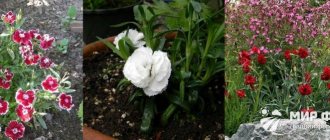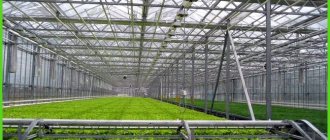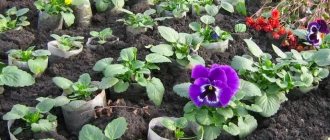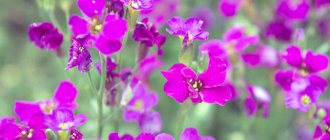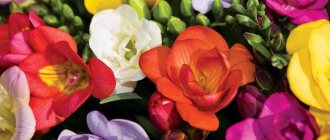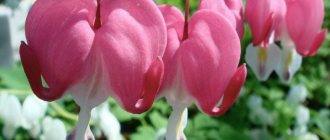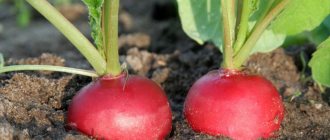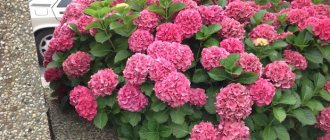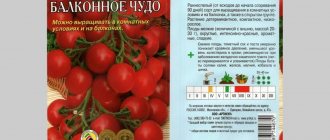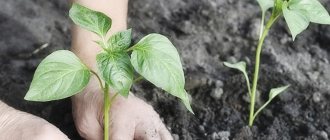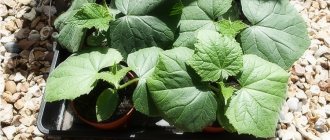Alwood carnation is distinguished by a rich variety of varieties and the flexibility of adaptation to different climatic conditions. It is thanks to this that this variety was able to take root and find wide distribution at all latitudes of Russia.
Alwood's carnation
It was named after Montague Alwood, who was involved in the selection and breeding of these flowers.
Myths about hybrid carnations: 3 none
I wanted to call this article “there are no indoor carnations,” but this title does not cover the whole topic, so it’s a myth.
hybrid double carnation (my garden)
First and main: there are garden carnations, and there are indoor ones.
I heard this statement from a very successful professional gardener and part-time blogger. So, with all due respect to the professionalism of the florist, I have to disagree - there are no indoor carnations!
It can winter well and not so well. That is why it is grown in pots, with the possibility of bringing it indoors for the winter.
https://www.youtube.com/watch?v=SyPhHjuhc74
flowerbed of hybrid carnation and fescue (more than 3 years)
To say that carnations are indoors is equivalent to saying that ostik or chrysanthemum, argyrantemum or the same petunia are also indoors!
These are all, of course, garden perennials that require certain wintering conditions.
white hybrid carnation
Why is it not advisable to keep carnations on a window in a room? It’s possible, but you will be exhausted by fighting endless pests and diseases that attack carnations indoors.
Yes, and the carnation needs to be provided with direct sunlight throughout the day and good ventilation, but at the same time its roots are afraid of overheating and drying out.
Therefore, these items are difficult to provide in the room.
The basic rule for growing cloves is to keep your feet cold and your head warm. Yellow hybrid carnation
What type is the so-called indoor or potted carnation?
Terry low-growing or border carnation refers to a hybrid garden carnation, or Shabot, crossed with Chinese or other low-growing and abundantly flowering forms. Perhaps the multi-flowering gene has been introduced, like in the multiflora chrysanthemum.
purple (but the camera does not accurately determine the color)
You can distinguish between different types of potted carnations: by the shape and size of the flowers and their number.
The most large-flowered and densely double ones came from Shabo. They bloom singly and winter worse.
Pink large-flowered hybrid terry carnation (no longer Chabot, but very similar)
Previously, Shabot was grown only for cutting. It has strong, powerful stems with a large, often single inflorescence at the top.
Since there was a huge demand for low-growing forms, it was reduced through hybridization, adding a large number of shortened stems (multiflora principle), but leaving rather large flowers.
The burgundy carnation even looks similar to the Chinese carnation, only with double the number of petals
This carnation is the most unpretentious of the hybrids and winters well in almost any conditions.
Carnations are annual, biennial and perennial.
No. Can not be. Cloves of any kind are a perennial plant. Sometimes it’s just not frost-resistant. But even this is not the determining factor of the postulate.
The main factor in determining its “flyability” is the timing of the growing season before flowering.
abundance of laid buds on a hybrid carnation
If it has a short growing season, and it blooms in the year of sowing, after 3-5 months like the Chinese carnation, then it is called an annual carnation.
And if more than 7-9 months must pass, like the Turkish one, then it is called two years old. Because usually such carnations are sown in the spring or summer of one year, and they begin to bloom only the next.
But absolutely all cloves are perennial!
The most unpretentious are wild species, feather grass and grass. It can grow for many years without transplanting in one place and without special care.
How to preserve cloves in winter
In order to enjoy the beauty of carnations next year, but without unnecessary problems, you can save the bushes in the winter and then make cuttings from them.
The strongest and healthiest bushes must be cut and placed in a pot along with a lump of earth. They should be stored in a cool place
How to cut carnations in spring? Cuttings of carnations in the spring should occur in the following stages:
- Cuttings are made from the part located in the middle; the cuts should be in the internodes; make sure that the cuts are oblique;
- The lower leaves are removed, and the cuttings are treated with a disinfecting solution;
- The cuttings are planted in boxes that must be filled with sand;
- Cover the cuttings with a clear plastic bag.
New leaves and roots will begin to appear in a few weeks, but do not forget to open the bag for a few minutes during the first two weeks, this procedure must be done every day.
Pests
- The spider mite is a tiny animal (!) 0.5-0.8 mm, covered with short whitish “hairs”, feeds on plant sap, leaving behind dry areas covered with a thin web. Lays up to 150 larval eggs on the back of leaves. As a result, the plant gets sick, slows down in development and dries out. How to fight: maintain the required landing distance; loosen and disinfect the soil more often.
- Spring fly - 8mm white larvae of this fly fall on plants and gnaw passages there, which is why the stems acquire a grayish color and lose their tightness, and then wither and rot. Treatment: be sure to thoroughly loosen the soil to a depth of 3-4 cm; use the drugs Aktara, Zemlin, Karate Zeon.
- - a small harmful insect that feeds on the sap of plant leaves and inhibits its growth. How to fight: use insecticides - Aktara, Karbofos, Fitoverm, Actellik, Biotlin.
- The spider mite is a tiny animal (!) 0.5-0.8 mm, covered with short whitish “hairs”, feeds on plant sap, leaving behind dry areas covered with a thin web. Lays up to 150 larval eggs on the back of leaves. As a result, the plant gets sick, slows down in development and dries out. How to fight: maintain the required landing distance; loosen and disinfect the soil more often.
- The earwig is an insect 2 cm long, brownish in color, feeds on the leaves, inflorescences and buds of the plant, as a result the plant dies. How to fight: collect pests by hand and treat the plantings with Fundazol.
- Thrips is a sucking insect 0.9 mm long that feeds on the sap of the plant, which is why it appears covered with a layer of grayish dust. How to fight: use insecticides, for example, Topaz.
Good luck!
What difficulties does a gardener face when growing cloves at home?
Alas, when growing carnations, some problems cannot be excluded, and these need to be taken into account even before planting the plant. Of course, it is not difficult to provide the proper conditions, but this flower is vulnerable to pests. For example, to these:
- spider mite - greatly impairs flowering and covers the back of the foliage with a white coating;
- aphid;
- powdery mildew.
Aphids and spider mites “love” indoor carnations very much.
Because of this vulnerability of the plant, everyone who grows it should be prepared for the fact that it will not be so rare to carry out antiparasitic measures.
Pest threats are very serious. If at least one plant on the windowsill is affected, the carnation must be removed from there immediately. If there are signs of pathologies, you need to wash the foliage with a soapy solution, carefully protecting the roots from getting soap on them. Once on the roots, the soap will definitely cause harm to the plant. The foam is washed off after a few hours, but it should not be left overnight.
You can get rid of pests using traditional methods or special preparations.
If all this turns out to be useless, it is recommended to buy special fungicides at the herbal pharmacy. Here are examples of drugs that are a kind of “heavy weapon” in such cases:
- "Actellik" - works well against most pests, but is toxic, and it is better to resort to it only when nothing else helps;
- “Fitoverm” is not so dangerous, but this does not prevent you from carefully following the instructions.
It is recommended to till the soil before planting cloves there.
Garden carnation in combination with other plants
All varieties of perennial carnations can be grown in various flower beds. They look great both in group planting and single planting.
When creating plant beds, it is important to consider that variegated carnations in rich shades will look good in a neutral and more restrained environment. Ideal partners for her would be:
- yarrows;
- broom kochia;
- graceful gypsophila;
- two-color ragwort.
Carnation in landscape design
Carnations with feathery flowers in a heavenly hue pair beautifully with bright blue bearded irises. But you should still avoid proximity to tulips. The thing is that the latter can infect decorative carnations with diseases, and those remedies that are usually used to treat carnations are not suitable for delicate tulips.
Variety selection
Nature has created about 300 types of carnations, but only about 10 are available for cultivation. The most common varieties of carnations are:
Turkish
This variety of carnation is a miniature bush on which many small inflorescences bloom.
The peculiarity of this variety is that inflorescences of completely different colors can be combined on one bush, from white to dark burgundy.
Growing Turkish carnation is absolutely no problem even for a novice gardener; it is easy to care for and grows quite quickly.
Cirrus
This variety of carnation came to us from the Alps, it looks quite unusual, and all because of its leaves with deep cuts. From a distance it may seem that these are not flowers, but terry balls.
Pinnate carnation is perfect for decorating paths or flower bed edges.
Chinese
The bluish tint is what makes this variety distinctive, the inflorescences come in different shapes, and the color usually ranges from white to dark red or burgundy.
The most common form of this variety is bicolor; many flower gardeners are confident that these are the carnations that can decorate absolutely any flower bed.
Chinese carnation
Dutch
This is a perennial variety of carnation, but this is not its only feature; it also blooms continuously, from the second half of June until the first frost.
Its color can come in a variety of shades, but the most common is red with a white border along the edge of the petals.
Dutch carnation
Plant care
Caring for feathery carnations
Carnations are planted in a permanent place in the spring - in April-May, placing them at distances of 20-40 cm, depending on the variety. To form continuous borders, gaps of 20–25 cm are left between low-growing varieties. After planting, the bushes are watered and mulched with peat or compost mixed with sand.
Watering and fertilizing
Feathery carnations do not tolerate too hot periods, quickly fade and lose their attractiveness. Moderate watering during dry seasons will help preserve the decorative effect longer. In addition, these perennials, planted in the rare partial shade of dwarf birches, rowan trees or low conifers, will not only look luxurious, but will also be able to survive the midday heat without loss.
Water the plantings every 7–10 days, trying not to damage the delicate petals with streams of water, so it is better to use ground watering.
Plants are fed at the beginning of flowering using soluble complex fertilizers for flowers, for example, the Kemira Flower brand. The second feeding is carried out in early September with fertilizer with a predominance of phosphorus, which will strengthen the root system and improve wintering.
With the onset of the first severe frosts, the carnation is hilled up with loose soil, covered with spruce branches, fallen leaves, reeds, with wooden boxes or wicker baskets placed on top. Polyethylene and other non-porous materials should not be used. In early spring, the covers are removed, the ground is loosened and the mulch is renewed.
Pests and diseases
Feathery carnation is one of the most unpretentious and resistant species, but is still susceptible to attacks by aphids, thrips, spider mites and cabbage cutworms.
Aphids and thrips are typical pests of carnations that can severely deplete young plants and deprive mature bushes of their decorative properties. Aphid colonies are visible to the naked eye, thrips damage is suspected when pale spots appear on the petals and leaves, the bushes are weakened, and the flowers often do not bloom. In case of severe damage, double treatment with insecticides is used - Intavir, Decis, Bi-58 or garlic infusion.
Cabbage moth caterpillars attack plants in early summer and quickly eat buds and young shoots. When a small number of cutworms appear, the caterpillars are collected by hand, and the bushes are treated with wormwood infusion with the addition of soap shavings. In case of a massive attack of pests, the plants and the ground around them are treated with one of the pesticides.
If the leaves turn pale, turn yellow, curl and dry out, and thin cobwebs are visible at the ends of the shoots, the plantings have been affected by spider mites. In this case, treatment is carried out with a suspension of colloidal sulfur or a solution of karbofos.
In cool, rainy weather, as well as when grown in cramped and damp greenhouses, carnations inhibit fungal diseases. The appearance of light brown spots with a dark border, and later black velvety spots on leaves and stems indicates the development of black spotting.
Dirty gray oblong lesions are a sign of Alternaria blight. If depressed brown spots with pinkish-brown fluff are visible at the base of the stems, and the stems rot and fall off, the plants are affected by fusarium.
In case of infection by a fungal disease, it is necessary to limit watering, increase ventilation, and treat the plants and soil with Fundazol (2 g per 1 liter of water) or copper oxychloride.
When brick-red or orange-colored tubercles (pustules) appear on the leaves, formed by the rust pathogen, the affected bushes are destroyed by digging up the roots. Healthy plantings and the soil surface are treated with a suspension of colloidal sulfur and sprinkled with sulfur powder mixed with fluff lime.
Tips for caring for her
Carnations do not require careful care, but they need constant watering and light, both before and after germination. In order for you to grow a large and beautiful carnation, you need to follow several rules:
- After sowing, place the container in a room with a temperature of 18-20 degrees;
- Watering before emergence should be done from a sprayer; the cloves should be watered when the top layer of soil dries a little; the soil should not be allowed to be too wet;
- It is necessary to ventilate the mini-greenhouse; to do this, just remove the lid for 20 minutes once a day.
With proper care, the first shoots can appear within 4-5 days
Irrigation scheme
Watering before the emergence of shoots should be done from a sprayer and only as the top layer dries, and after the first shoots appear, watering should be done even more carefully.
In no case should you pour too much water in too large a stream; the plant is very susceptible to fungal diseases, and excess moisture can become a catalyst for the occurrence of these diseases.
Water should not be allowed to get on the stems and leaves; it is best to water the sprouts from a syringe
Top dressing
The carnation will delight you with its beauty if you take care of it in a timely manner; in addition to watering, you can sometimes feed the plant. At the initial stage of cultivation, nitrogen-containing fertilizers are suitable.
It is best to choose complex fertilizers that contain all the necessary substances.
Fertilizers must be applied strictly according to the instructions on the package; intentionally increasing the dose will only harm the plant.
Picks
Picking should be done only when you see that the plants have developed sufficiently and can withstand transplantation. The first pick should be no earlier than the first two green leaves appear, and the second – four leaves.
Before picking, you need to treat the soil and container, this is necessary in order to avoid any diseases
Carnation transplantation scheme:
- Before replanting, water the soil thoroughly;
- Prepare the container for transplantation: make drainage holes and lay a drainage layer, and fill the container with soil;
- Next, look how much the root has grown and make a hole slightly larger than the entire root system;
- Move the sprout to a new container and dig down to the cotyledon leaves.
After the procedure, you need to let the plants adapt a little, then they can be treated with a growth stimulator solution.
Soil and pot
Cloves are unpretentious when it comes to substrate. Some gardeners advise using turf soil, peat and sand in a 2:1:1 ratio. Carnation is a flower that does not like high humidity, including soil. In this regard, you need to add a little more sand than in the pots of other plants.
If you don’t have time to mix the substrate yourself, it will be enough to pour ready-made universal soil into the container. It is sold in any flower shop. It may lack a number of fertilizers that cloves need, but these are added later.
Chinese double carnation - sow and get the true charm of a flower garden
Important! The pot must have drainage.
Drainage is made from expanded clay or small stones purchased at a specialized store. The bottom layer should easily allow water to pass through so that it does not stagnate in the soil. Carnations are prone to the formation of root rot, which can not only affect flowering, but also completely destroy the plant.
The pot is selected at the discretion of the owner. If you plan to plant a creeping plant variety in it, a wide and flat container will be more convenient. For species with a standing stem, take deeper pots. They must have holes for proper drainage.
It is recommended to pay attention to plastic containers equipped for submersible watering: carnations tolerate it better than standard moistening using a watering can
Diseases and pests
Alwood is a southern plant and when growing in harsh Russian climatic conditions it can have many diseases:
- Rust - when the foliage is covered with rust. It is necessary to cut off the affected areas in time and spray with Fungicide.
- Speckled - when strange spots appear on the leaves, deformation of the inflorescences. More often this is a viral infection with fungi. Most likely, the reason is improper care and excessive watering.
- Alternaria blight - when the stems and leaves become covered with brown spots and the flowers wilt. Treatment is fungicides.
- Fusarium, when there is wilting and falling of flowers, improper development of stems. The main pest of carnations is thrips in the form of sucking insects, leading to damage and eating of leaves, deformation of stems, and drilling of petals. Insecticides for spraying (Fufanon, Aktara, Fitoverm) are used in the fight.
The most common pests:
- aphids as a pest causing deformation of stems and stickiness of leaves. The reason may be insufficient watering or keeping the cloves in too dry air. Phytoncides are used for control;
- nematodes that can lead to damage to leaves, stems and roots when warty growths appear. The soil needs to be disinfected. It is possible to transfer the seedlings to another healthy planting material;
- carnation fly in the form of gray insects with a body up to 7 mm in length. It is the larvae that harm the stems and leaves, leading to wilting and death of the affected parts of the shoots. What can be done? Carry out chemical treatment with insecticides or heat (steam) when placing seedlings in greenhouses. Rotten plant remains must be burned so that they do not become a source of infection for other healthy seedlings;
- The spider mite leads to the sucking of juices from the shoots and leaves of the clove. On the leaves you can see discolored areas in places. The reason may be dry air or high temperature. Insecticides are applicable for control, but they need to be alternated due to the rapid adaptation of the tick;
- butterfly-shaped clove roller up to 22 mm in length. It eats ovaries and leaves, creating a cobweb network on them. Treatment is with insecticides by spraying.
Alwooda's appearance is stunning. This is a real decoration for any garden or flower bed. You can plant it in a strip, creating a kind of border in the garden plot. To make the plant less painful, you need to harden off the seedlings as soon as they sprout. It is also better to plant in the garden, in open ground. After all, it is greenhouse plants that are less resistant to the onslaught of pests and diseases.
Alwood carnation is widely used to decorate garden plots and flower beds.
Prevention from many lesions is timely mulching of the soil, creation of normal conditions for the growth and vegetation of carnations, and digging of the soil in autumn. In case of disease, diseased plants should be immediately removed and the soil should be treated with fungicides.
It is much easier to plant cloves with seeds than with cuttings. Having shown care and attention, Alwooda will reward you with the appearance of luxurious double inflorescences of different tones and will delight you all summer, right up to frost.
https://youtube.com/watch?v=p-kRPZnkJ7A
Alwood carnation is distinguished by a rich variety of varieties and the flexibility of adaptation to different climatic conditions. It is thanks to this that this variety was able to take root and find wide distribution at all latitudes of Russia.
Alwood's carnation
It was named after Montague Alwood, who was involved in the selection and breeding of these flowers.
Diseases and pests
Alwood is a southern plant and when growing in harsh Russian climatic conditions it can have many diseases:
- Rust - when the foliage is covered with rust. It is necessary to cut off the affected areas in time and spray with Fungicide.
- Speckled - when strange spots appear on the leaves, deformation of the inflorescences. More often this is a viral infection with fungi. Most likely, the reason is improper care and excessive watering.
- Alternaria blight - when the stems and leaves become covered with brown spots and the flowers wilt. Treatment is fungicides.
- Fusarium, when there is wilting and falling of flowers, improper development of stems. The main pest of carnations is thrips in the form of sucking insects, leading to damage and eating of leaves, deformation of stems, and drilling of petals. Insecticides for spraying (Fufanon, Aktara, Fitoverm) are used in the fight.
The most common pests:
- aphids as a pest causing deformation of stems and stickiness of leaves. The reason may be insufficient watering or keeping the cloves in too dry air. Phytoncides are used for control;
- nematodes that can lead to damage to leaves, stems and roots when warty growths appear. The soil needs to be disinfected. It is possible to transfer the seedlings to another healthy planting material;
- carnation fly in the form of gray insects with a body up to 7 mm in length. It is the larvae that harm the stems and leaves, leading to wilting and death of the affected parts of the shoots. What can be done? Carry out chemical treatment with insecticides or heat (steam) when placing seedlings in greenhouses. Rotten plant remains must be burned so that they do not become a source of infection for other healthy seedlings;
- The spider mite leads to the sucking of juices from the shoots and leaves of the clove. On the leaves you can see discolored areas in places. The reason may be dry air or high temperature. Insecticides are applicable for control, but they need to be alternated due to the rapid adaptation of the tick;
- butterfly-shaped clove roller up to 22 mm in length. It eats ovaries and leaves, creating a cobweb network on them. Treatment is with insecticides by spraying.
Alwooda's appearance is stunning. This is a real decoration for any garden or flower bed. You can plant it in a strip, creating a kind of border in the garden plot. To make the plant less painful, you need to harden off the seedlings as soon as they sprout. It is also better to plant in the garden, in open ground. After all, it is greenhouse plants that are less resistant to the onslaught of pests and diseases.
Alwood carnation is widely used to decorate garden plots and flower beds.
Prevention from many lesions is timely mulching of the soil, creation of normal conditions for the growth and vegetation of carnations, and digging of the soil in autumn. In case of disease, diseased plants should be immediately removed and the soil should be treated with fungicides.
It is much easier to plant cloves with seeds than with cuttings. Having shown care and attention, Alwooda will reward you with the appearance of luxurious double inflorescences of different tones and will delight you all summer, right up to frost.
Alpine carnation is a low-growing perennial plant with bright pink flowers. Representatives of the family fully justify their name, preferring to settle at an altitude of 1000–2000 meters. In the wild they are found on the slopes of the eastern Alps, in the mountains of Slovenia and Austria. The natural form of the perennial is more demanding in terms of growing conditions and does not tolerate cultivation well, but the varieties and hybrids created on its basis feel great in the garden.
The homeland of alpine carnation is the mountain slopes of the eastern Alps
We grow in open ground
Sowing of perennials is carried out in May at an outside temperature of +15C. For landing:
- dig up and fertilize the soil;
- prepare seeds;
- deepen at a distance of 5-6 cm from each other. When sowing in flower beds, you can do this in a chaotic manner;
- cover the plantings with film until the first shoots appear;
- then remove the covering material;
- thin out when the second leaf appears.
When planted in the sun, Alwood will be more compact, the color of flowers and leaves will be brighter, but the flowering period will be shortened
Basic conditions for planting Alwood in the ground:
- presence of a sunny area;
- drained, light and moderately fertilized soil. It is good to add peat and sand if there is clay soil.
Cloves are unpretentious and winter-resistant. Even an inexperienced gardener can handle planting. But for the winter you need to snatch up the seedlings with spruce branches and mulch the bushes.
Peculiarities of propagation of perennial carnation
If Turkish carnation is already growing at your summer cottage, propagation by cuttings is the most reliable way to obtain planting material while preserving all the qualities of the mother bush. Cuttings are carried out in June. To do this, cut healthy cuttings 10 cm long. The lower cut is made oblique at a distance of 1-1.5 cm from the knee of the stem.
The prepared material is planted in sandy soil, well moistened and covered with film. After 20 days, the cuttings will take root and in the second half of August they can be planted in a permanent place.
Turkish carnation - propagation by cuttings
Cirrus, Dutch and Turkish carnations take root well, propagation of which is carried out by dividing the mother bush. It is carried out in the spring or after flowering. The cuttings are cut from the rhizome with a knife or a shovel and planted in a new place at a distance of 30-40 cm.
Dividing a garden perennial carnation bush
Let's talk about secrets.
Have you ever experienced joint pain? And you know firsthand what it is:
- inability to move comfortably and easily;
- pain during or after exercise;
- discomfort when going up and down stairs;
- inflammation in the joints, swelling;
- unpleasant crunching, clicking not of your own accord;
- causeless and unbearable aching pain in the joints.
Please answer the question: are you satisfied with this? Can such pain be tolerated? How much money have you already spent on ineffective treatment? It's time to end this! Do you agree? Today we are publishing an exclusive interview with Professor Dikul. in which the doctor revealed the secrets of getting rid of joint pain, treating arthritis and arthrosis.
Did you like the material? Be sure to save it to your social networks, or just print it:
Copyright © “Vsadu.ru” 2010-2017 Copying and modification of site materials is possible only with the written consent of the copyright holders. Articles are protected by the law on copyright and related rights; when quoting materials from the Vsadu.ru project, a direct open link to vsadu.ru is required. All rights reserved.
We can notify you about new articles so that you are always aware of the most interesting things.
Growing alwood cloves from seeds
The varieties are mainly perennial. The list of their breeders is replenished every year. Alwood comes in different colors. Flowers - with many different shapes. Petals have a contrasting border around the edges.
Alpine carnation - description of the species
A bright green shrub 20–25 cm high with delicate flowers invariably attracts the attention of gardeners with its grace and unpretentiousness. Thin, slender stems with narrow leaves form fairly large cushion-shaped clumps that thrive in the extreme conditions of temperate and northern latitudes of Russia
The flowers of Alpine carnation are large, about 5 cm in diameter, with a characteristic, jagged edge. They consist of five slightly ruffled petals of a bright pink hue with a purple base. The plant blooms from June to October, spreading a delicate aroma around and delighting the eye with an abundance of colors.
. Translated from Greek, carnation means “divine flower” and is considered a symbol of love and a happy marriage.
In autumn, the carnation bears fruits that resemble an oblong capsule with four teeth on top. When ripe, they open, scattering small spherical seeds around the plant.
Soil and seed preparation
Planting seeds to obtain seedlings is carried out from January to March. The substrate for plants is prepared in the fall. For it, soil is taken from a garden plot, wood ash and sand are added.
The use of purchased land is allowed. The main requirements for the substrate are neutrality, lightness and fertility.
The soil is steamed in a water bath or watered with a weak solution of potassium permanganate for disinfection. Before planting, water the soil generously with warm water.
Tip! To improve the germination of seeds, place them in warm water for a day.
The substrate is poured into containers or cassettes. Plant seeds are placed in increments of 2 cm. When planting in separate cassettes or cups, 2-3 seeds are placed in each of them. The planting material is deepened by 1 cm. A thin layer of sand is poured on top.
The containers are covered with plastic film to create a greenhouse effect. If you are in a warm place, carnation shoots will appear in 10-14 days. During this time, you need to ensure that the soil remains moist, and also turn the film over to ventilate the plantings.
Reproduction methods
Reproduction is possible in three ways: using seeds, cuttings or layering. Most often, cloves, herbaceous or pinnate, are grown using seeds. This is a fairly simple method that does not require special skills. Maintenance is also simple.
Moreover, it is possible to sow both in pots for seedlings and directly into open ground. If the decision is made to grow seedlings, then planting should be done in the first half of March. You need to prepare a suitable soil mixture, not forgetting to disinfect it.
Place it in containers, sow the seeds and cover with film.
Care
Carnations do not need frequent watering. It is enough to water moderately once every 2-3 days in open ground - in the evening hours, pouring no more than 0.5 liters under the root of each seedling. You also need to periodically:
- apply fertilizers (humus, rotted manure, minerals);
- remove weeds;
- loosen the soil;
- trim the stem to 15 cm in height, but only after Alwooda’s flowering stops.
If you properly care for the plant, it can grow in one place for up to 5-6 years without needing replanting.
https://youtube.com/watch?v=mu9aHUYYTa8
As a rule, many varieties bloom only 2 years after the green mass has fully grown. If drying and yellowing of the leaves are noticed during this growing season, it is recommended to feed Alwood by adding humus (but not fresh), urea, and fertilizers with nitrogen. Although there should not be a supersaturation of nitrogen in the soil.
In the second year of the growing season, you need to add urea to the soil, and during the budding period - superphosphate and mineral additives (Master, Universal, Pokon, Kemira).
Alwood carnation varieties
The varieties are mainly perennial. The list of their breeders is replenished every year. Alwood comes in different colors . Flowers - with many different shapes. Petals have a contrasting border around the edges.
Perennial
Perennial carnation
A variety with a truly rich palette of shades. Double flowers up to 3 cm in diameter will decorate any flower bed or alpine hill . The garden will be fragrant with flowers strewn with red, pink, white, purple tones. The aroma that comes out is truly extraordinary. Carnations bloom continuously starting in June. Residents of southern countries observe colorful blooms all year round.
Ural
Carnation Ural
This is a resident of rocky slopes and steppes in the Urals. Main characteristics of the Ural carnation : branched stems with the formation of bushes in the shape of a ball, single flowers on the tops of the trunks with pink petals in the upper part and yellow-green below. The plant is drought resistant. It goes well in flower beds with other types of flowers.
Alpine beauty
Carnation Alpine beauty
Carnation, with a stem height of up to 25 cm, is famous for the splendor of its red buds with a purple center in the middle. Peduncles are tender, with a weak aroma. They are planted mainly with seeds and, better yet, on elevated , unshaded areas in sufficiently fertilized soil, although excessive nutrition is harmful. It will be extremely difficult for Alwood to endure wintering.
Amurskaya
Amur carnation
This is a perennial plant up to 60 cm in height. The leaves are lanceolate green, the flowers are pink, pale lilac. Flowering period – June-September . The ripening of Amur carnation seeds occurs only closer to October.
Mountain dawn
Carnation Mountain Dawn
A low-growing perennial with a stem up to 20 cm in height. The flowers are pale pink up to 2 cm in diameter . Flowering period – June-July. Grows well on loams, borders, rocky hills.
Travyanka
Carnation Grass
Flowers are pale pink up to 15 mm in diameter, stems and leaves are pink-red with purple spots, pubescent hairs and short cilia at the base. Travyanka's habitat is curbs, alpine hills . Flowering period June – September. Fruiting begins in mid-July.
Cirrus
Carnation Pinnate
Perennial with a stem height of up to 35 cm. Leaves are oblong and linear. The flowers are single, double, white, carmine, and dark pink in color, emitting a pleasant fragrant aroma .
This variety of carnation grows well in rock gardens, where it successfully survives wintering.
Hybrid
Carnation Hybrid
Inflorescences - simple and double white, red, pink. Stems – up to 30 cm in height. Blooms profusely until October . Takes root well in pots and flower beds. The main thing is to prepare drained, fertile soil and a warm, sunny place. Such hybrids, bred by a breeder, can grow on windowsills and withstand severe frosts in winter up to 50 degrees.
Planting carnations
Perennial garden carnations prefer sunny areas of the soil, but if you choose shade or marshy soil, you will not be able to get a strong crop and rich flowering. The soil should have neutral acidity. It is optimal if it turns out to be peaty, sandy loam and loamy. You can reduce the acidity of the soil using dolomite flour, and make it lighter using sand and regular peat.
Plant carnations in a sunny area
Seeds are planted in March, when the air temperature reaches a stable mark of +15ºС. Then they are lightly sprinkled with earth, moistened and a film is laid on top. At a temperature of +18ºС the first shoots appear. Now you can lower the temperature a little and place the boxes with seedlings in the light. The carnation peaks with the appearance of the second leaf. This is done very carefully, without deepening the root collar. Seedlings are planted in open ground at a distance of at least 30 cm.
Features of cultivation
The peculiarity of growing cloves is that it does not require several stages of picking. Doing this at home is much easier than in the open ground.
Carnations are planted early, and not every region can boast of warm winters, so an additional source of heat and light will be required.
Selection of capacity
There are no strict requirements for the capacity, the main thing is that it is large, but not very deep. A regular plastic container or cardboard box works well.
After picking, the sprouts will need to be transplanted into separate pots or peat tablets, in which case they may be smaller but deeper.
Seed selection and preparation
When you come to the store to buy seeds, carefully inspect the packaging; there should be no damage to it. They may indicate that the seeds were transported or stored incorrectly, this leads to damage to the planting material, and bad material will not produce beautiful flowers.
Before planting, he recommends disinfecting the seeds; to do this, it will be enough to soak them in a solution of potassium permanganate for 15-20 minutes. Disinfection can avoid any diseases.
Disinfection of seeds before sowing
You can also treat the seeds with immunomodulators, they strengthen the plant’s immunity.
When purchasing a package of seeds, check for recommendations on the back; there should also be information about the manufacturer.
Soil preparation
Soil for carnations can be bought in the store; universal soil for flower crops is suitable for it. But you can do it yourself, for this you will need:
- River sand, it must be washed;
- Turf land;
- Peat;
- Humus.
Make sure that the soil is light and loose; it should allow moisture and air to pass through well.
After preparing the soil, it must be disinfected; to do this, it must be steamed for one hour.
Direct sowing
In order to create optimal conditions for carnation germination, you need to follow the following steps:
- If your container does not have drainage holes, then you need to create them, this will prevent water stagnation;
- Next, we create a drainage layer, but it should not be thicker than 2 cm;
- Fill the container with soil, but not to the very brim;
- Don't forget to moisten the soil with a spray bottle;
- After the liquid is completely absorbed, make small indentations;
- Plant seeds in the holes and cover with a small layer of sand;
- Do not forget that after all the procedures you also need to water;
- Create a greenhouse effect in your mini-garden by covering the container with a bag or lid.
Water for irrigation at all stages of planting must be infused and clean; in no case should you use tap water
The best varieties and hybrids
Chinese carnations have been grown for decorative purposes for more than three hundred years, and during this time numerous attractive forms, spectacular varieties and hybrids have been obtained.
In amateur floriculture, special attention is paid to dwarf varieties with compact bushes reaching a height of 15–20 cm, which are characterized by lush flowering
Very popular are garden-shaped varieties of Chinese carnation Heddevig with rounded bushes 30–35 cm high and large single or double flowers with a diameter of 5–6 cm.
Carousel (Merry Go-Round)
Chinese carnation variety Carousel (Merry Go-Round)
The joyful flowers of this dwarf variety of Chinese carnation will decorate a flower bed and look great in a hanging planter or flowerpot on the porch. The bushes are neat, up to 20 cm high, with knotty stems and numerous white flowers with a diameter of 5–6 cm with a scarlet center.
The cut edges of the petals and shiny, radiant texture add even more charm to the pretty variety. Flowering is long - from the beginning of July until autumn frosts.
Vorozheya
Chinese carnation variety Vorozheya
A wonderful variation of Heddevig's carnation with densely branched stems of light green color, forming small bushes about 35 cm high. The plants are completely covered with double flowers with a diameter of 4–5 cm. The petals are satiny, crimson-black with a jagged edge and a bright white border.
Flowering is very generous, from July to October frosts. This is one of the best terry dark-colored varieties - very impressive and unpretentious.
Diana F1 Crimson
Chinese carnation variety Diana F1 Crimson Picotee (Diana F1 Crimson Picotee)
A bright hybrid of Dutch selection is distinguished by large colorful flowers with a diameter of 7–8 cm, decorating a small neat bush 20–25 cm high. The petals are wide, round, open, rich red in color with a fine-toothed edge. The flowering is luxurious - from the beginning of July until the chilly autumn cold. This hybrid is an excellent choice for pots or borders.
In addition to the colorful Crimson uniform, the series includes many other attractive variations, the most interesting of which are:
- Diana F1 White – snow-white with a split edge of the petals;
- Diana F1 Blueberry – bright purple;
- Diana F1 Crimson Picotee - with corrugated dense pink-raspberry petals;
- Diana F1 Scarlet – fiery red, catchy.
Grace F1 Crimson
Chinese carnation variety Grace F1 Crimson (Grace F1 crimson)
Another stunning red hybrid from the same Dutch producer, Hem Genetics. Unlike the previous series, these plants are decorated with double, full flowers. Low bushes, growing, form dense borders or flowering lawns.
Plant height is 18–25 cm, flowers are very large, 6–8 cm in diameter, with a fringed edge. The Grace F1 Crimson form is characterized by flowers of a rich wine-red color with spectacular white stamens.
The series also includes other beautiful varieties:
- Grace F1 Salmon – salmon pink;
- Grace F1 Dark pink (Grace F1 Deep rose) – raspberry pink;
- Grace F1 White – sparkling white.
Hybrid Chinese carnations Grace are suitable for indoor cultivation.
You will find information about other interesting types and varieties of carnations in the article “Carnations - the best varieties and hybrids.”
Propagation of alpine carnation
Perennials are propagated in several ways, but the simplest and most convenient option is seed cultivation. In this case, sowing is possible both for seedlings and directly into the ground. Only adult plants from the second year of life are propagated by cuttings and layering.
Growing alpine carnation from seeds
Sowing at home is carried out in February-early March. If you plant the plant later, there may not be flowering this year. The soil for cloves is prepared from ordinary garden soil, adding sand and ash. The main requirement is that the soil must be light and loose, with a neutral pH.
Work order:
- The prepared mixture is mixed and poured into boxes.
- The soil is compacted and watered with warm water.
- After 1.5–2 hours, grooves 1 cm deep are made in the moistened soil.
- Seeds mixed with fine sand are placed in the holes and carefully sprinkled with soil.
After the first shoots appear, the containers with seedlings are transferred to a bright windowsill with a daytime temperature of 20° C. In the evening, the seedlings are illuminated using special phytolamps or fluorescent lamps.
Alpine guest seedlings require minimal watering, otherwise there is a high probability of blackleg appearing. The disease develops especially often in poor lighting and low temperatures.
In the phase of 1–2 true leaves, the seedlings are planted, planting 2 plants in each cup. In the future, the weaker flower is simply removed. When 5–6 leaves appear, pinch the cloves, thereby enhancing the regrowth of side shoots.
With the arrival of warm, sunny days, the grown seedlings are taken outside for hardening. If possible, young plants are placed in a greenhouse, protected from night frosts with lutrasil. Bushes that have grown stronger in the sun and fresh air will bloom much earlier than pampered home seedlings. The photo below shows an alpine carnation ready for planting in open ground.
The flower is planted in a permanent place in late May-early June, when the threat of night frosts has passed.
Sowing alpine carnations in the ground
If you don’t want to bother with seedlings or there is no room for them in the house, you can sow the alpine beauty directly into open ground. The spreading bed is cleared of weeds, dug up and limed. In the third decade of May they begin sowing.
Landing rules:
- In the prepared area, grooves 0.5 cm deep are marked every 10 cm.
- Clove seeds mixed with sand and a pinch of dry complete mineral fertilizer are scattered lightly into the grooves.
- The bed is leveled and watered with warm water.
- The top of the planting is covered with film to retain moisture.
After emergence of seedlings, polyethylene is replaced with lutrasil and left for 10–12 days. Water the young bushes directly through the shelter.
An overseas guest sown in the ground will bloom only next year. At the end of August, the grown bushes are planted in a permanent place. To make them more magnificent, the tops are pinched after the 8th leaf has developed.
When to sow cloves for seedlings, in what month
If you really like carnations and want to plant them in your garden or vegetable garden, then most likely you are wondering when to sow cloves?
The best time to sow carnations is the end of January or the first days of February; some flower beds sow them in early March, but you don’t need to do this too late. The plant needs quite a long time to develop normally.
You also need to take into account the climatic characteristics of your region, for example, the optimal time for sowing in Moscow is mid-February, and in the southern regions the last days of January are suitable.
You can navigate according to the lunar calendar, this is very convenient, because you can immediately determine both favorable and unlucky days
Days on which it is best to sow seedlings:
- January – 27-29;
- February – 1-8, 10-20, 25-28;
- March – 2-14, 29-31;
- April – 1, 2, 5, 6, 7, 9, 18-20, 24, 25.
Days on which it is strictly forbidden to work in the garden:
- January – 10, 25,26;
- February – 9, 21, 22, 23;
- March – 9, 19, 20, 21,24;
- April – 8, 15,16, 17,23.
